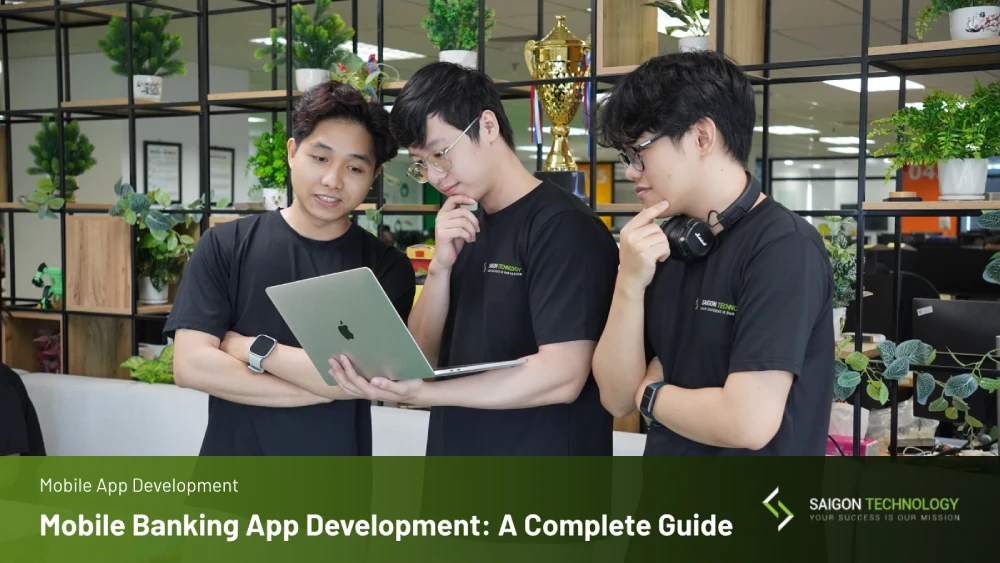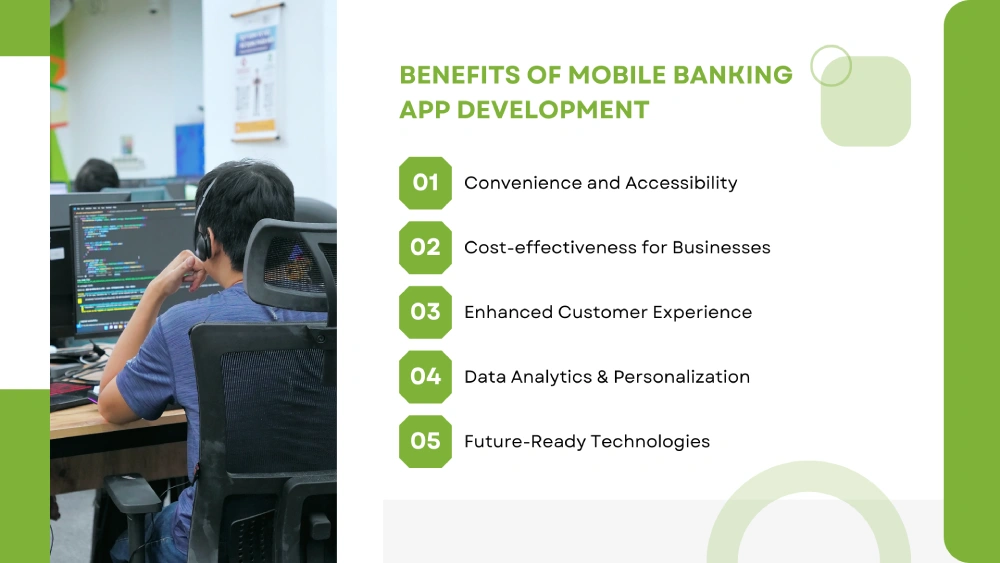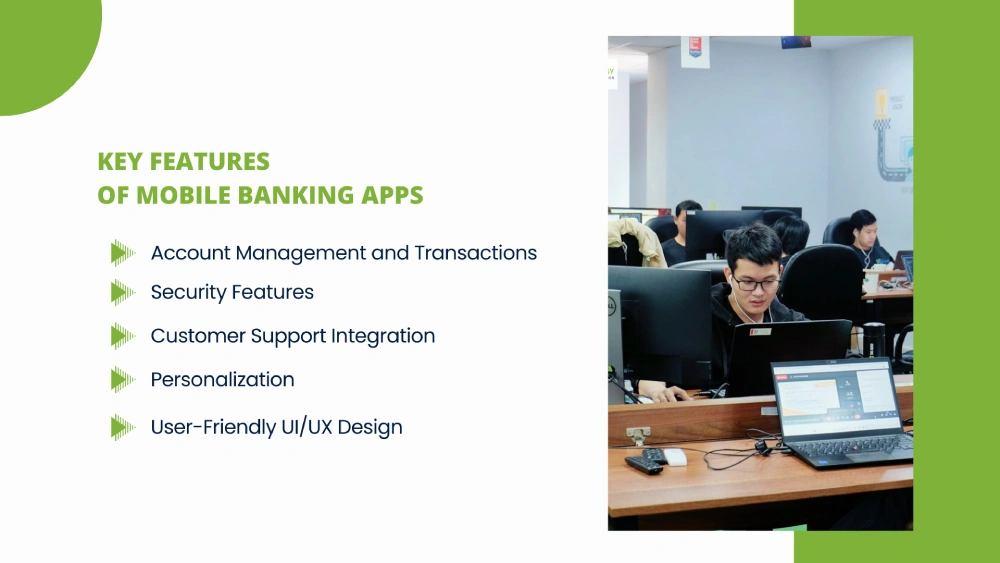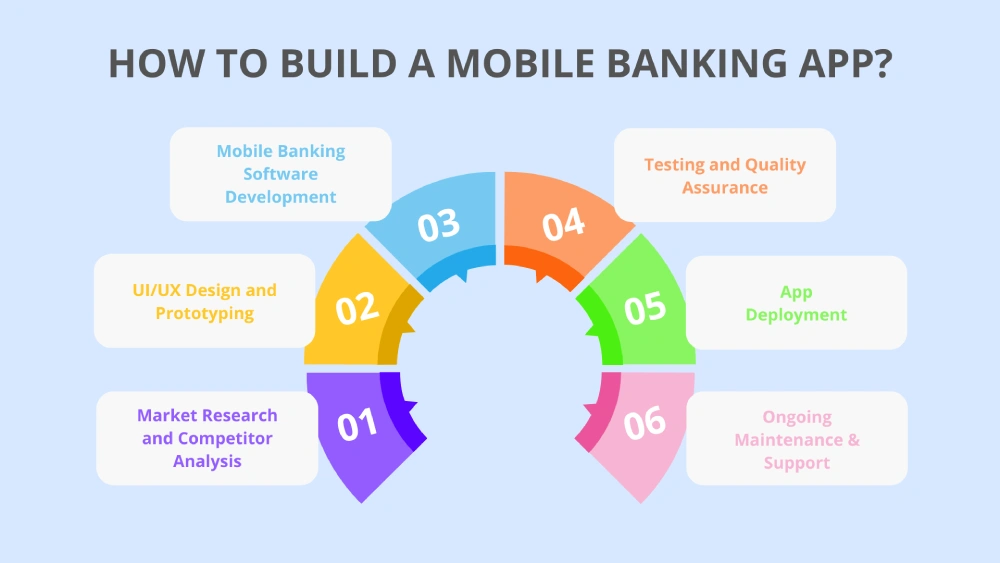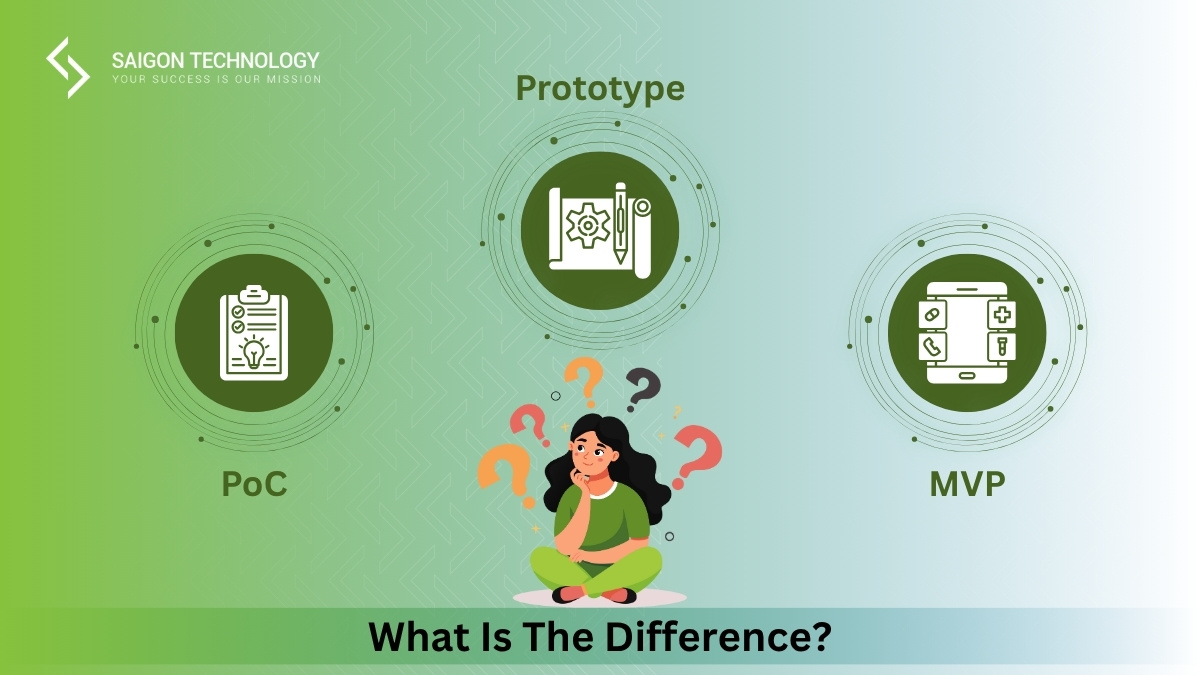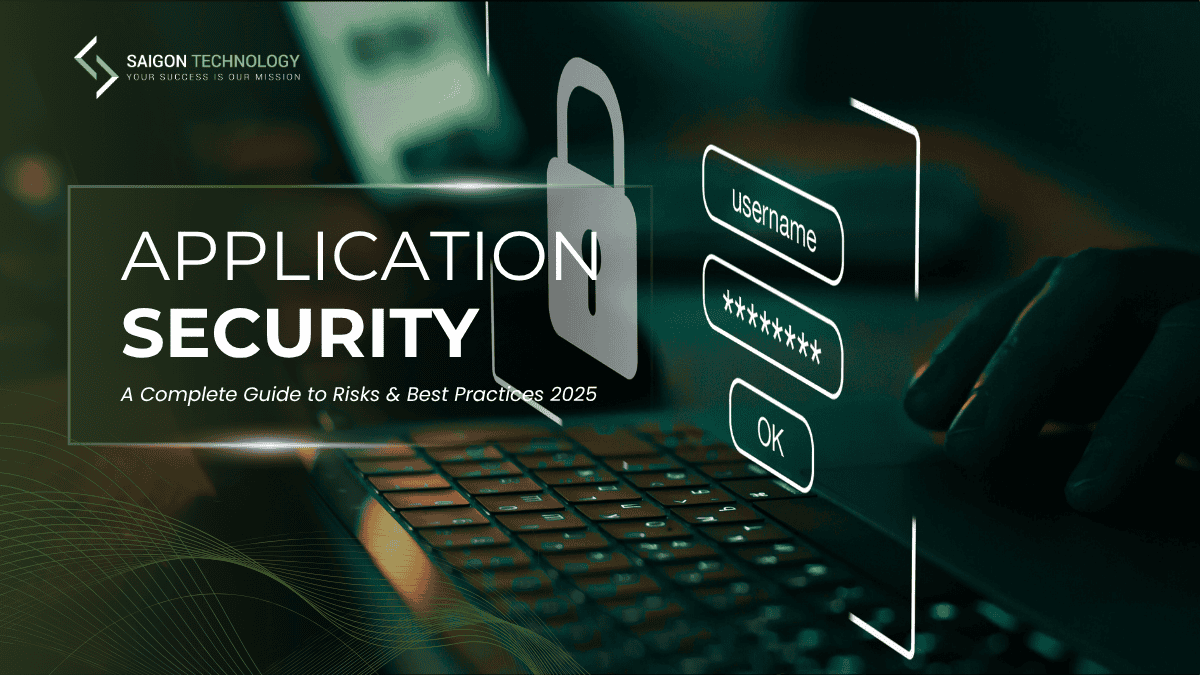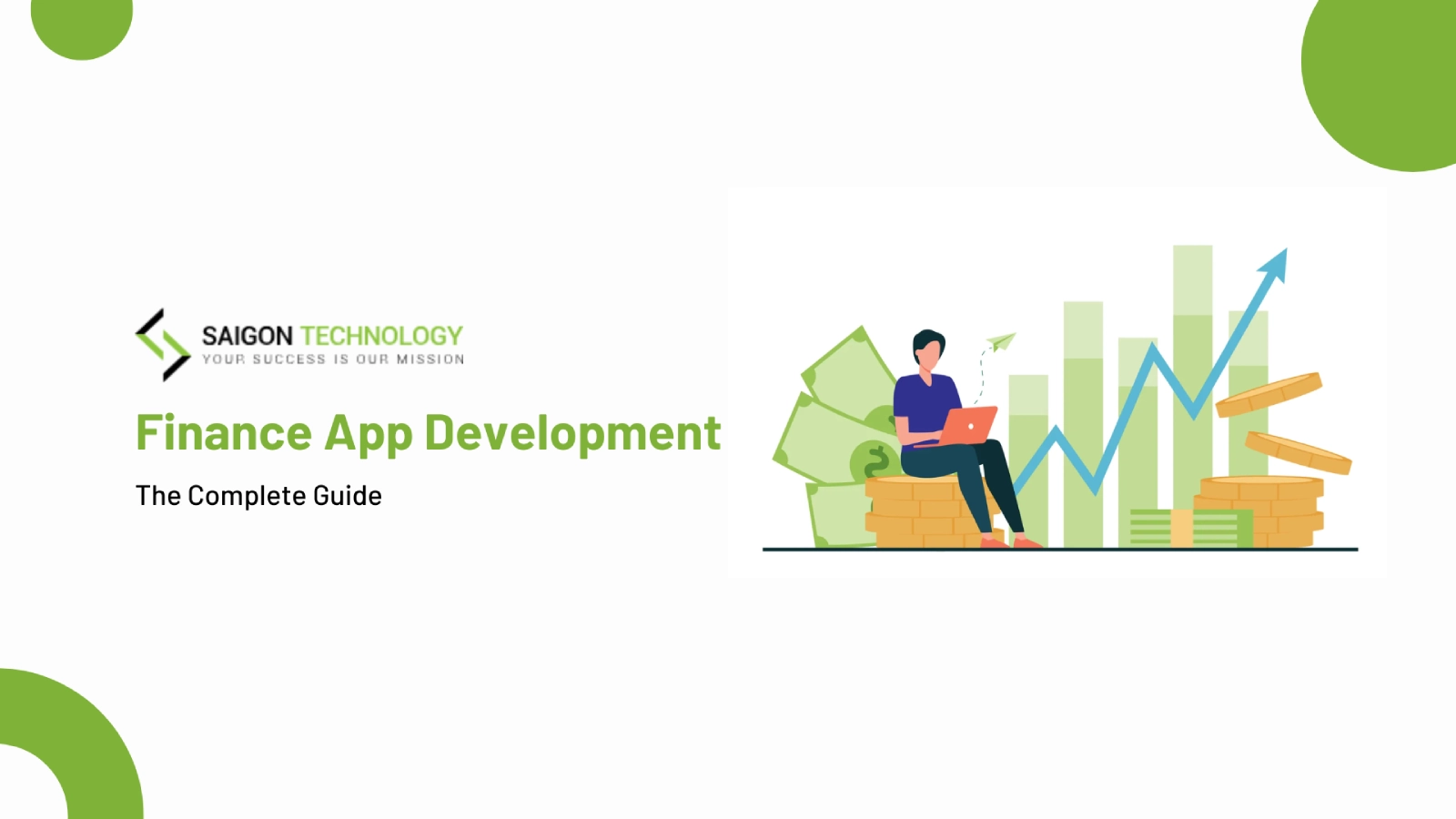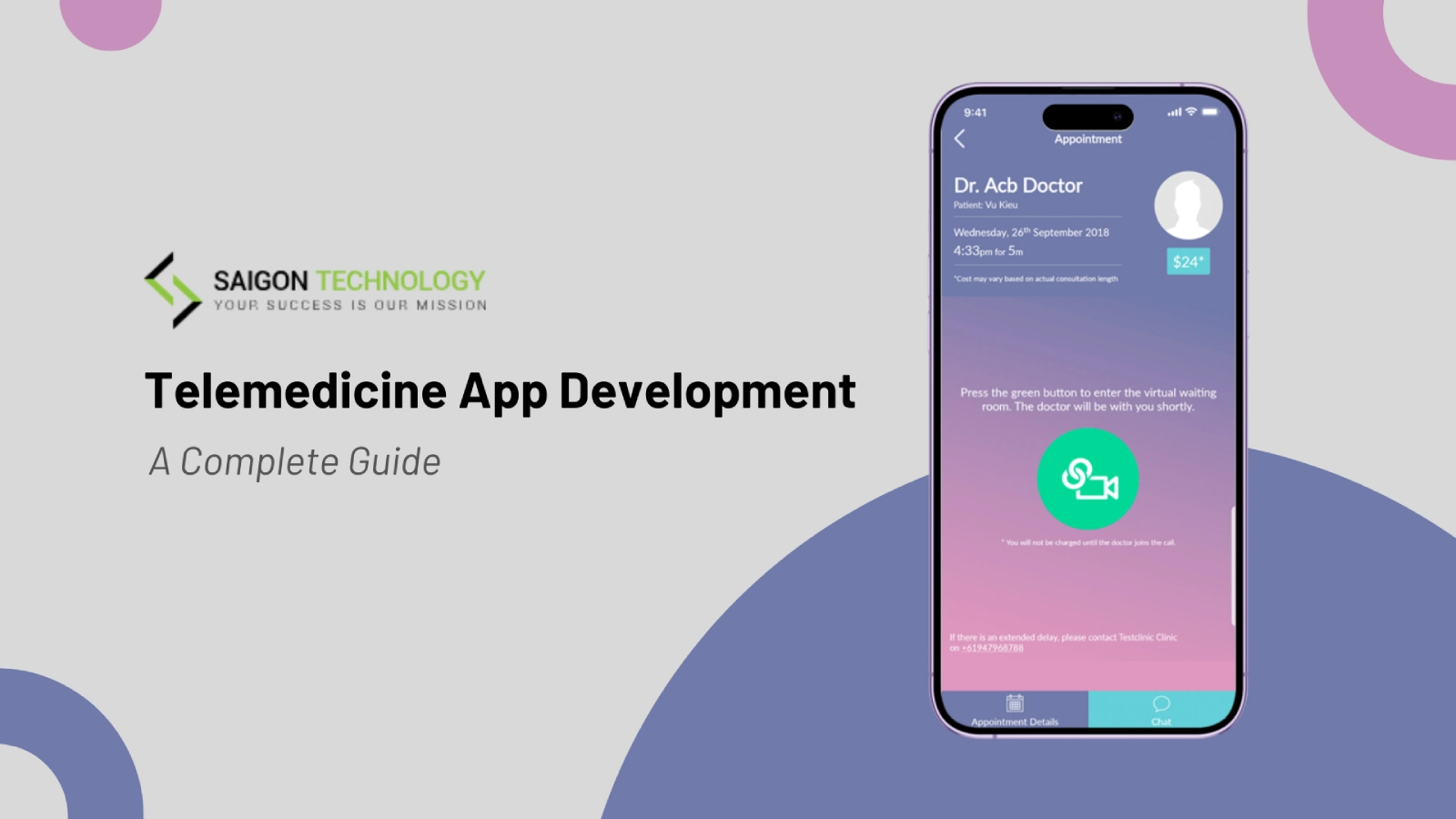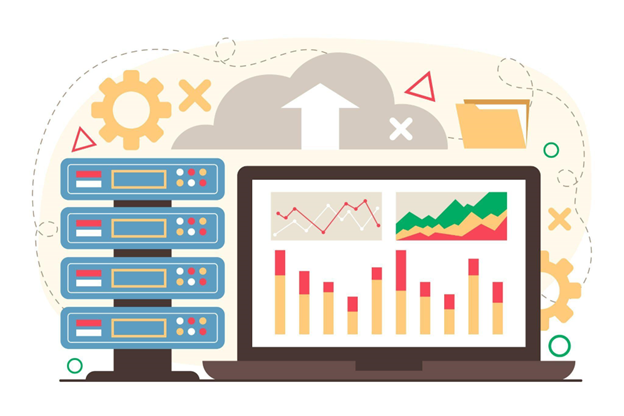Curious about mobile banking app development? You are in the right place. Mobile banking apps have really changed the way we manage our money. In the United States, many banked households rely on mobile banking as their main access method. Between 2015 and 2021, the percentage of these households increased about fivefold, reaching 43.5%. This article covers everything, from the benefits of mobile application development for banking to must-have features. You can also check out the possible challenges and emerging trends in the industry. Let’s dive in!
What is a Mobile Banking App?
A mobile banking app is a digital application that helps users manage their financial accounts. This task involves checking account balances, paying bills, and transferring funds. The best thing is that users can complete it all with a few taps on their smartphones or tablets.
Mobile banking apps are right on your devices. Thus, you don’t have to physically visit bank branches. Furthermore, the apps work around-the-clock. Users can access them 24/7, while banks only operate during business hours.
Benefits of Mobile Banking App Development
Banking app development offers tons of benefits for businesses and users. If you plan to build a banking app, let’s see what you can get!
Convenience and Accessibility
Thanks to the development of mobile banking, users don’t have to run to the bank. With the app in your hand, you can conduct transactions at any time and from anywhere.
One of the standout features is 24/7 support. AI-powered chatbots and customer support provide round-the-clock assistance. Whenever users need guidance, the support team is at their fingertips.
Voice-activated banking is another plus. With simple voice commands, users can make payments. This feature is perfect for multitaskers or when you just don’t feel like typing.
Cost-effectiveness for Businesses
Mobile banking application development reduces the need for physical branches and paper-based processes. Thus, businesses can cut operational expenses. Automation tools like AI chatbots and push and in-app notifications lead to lower customer service costs. Customers can get help without relying on human staff.
The benefits don’t stop there! Businesses use banking apps to reduce manual processes and streamline their processes. Some add multi-factor authentication to build trust. These features help enhance user engagement. Over time, businesses will notice a solid return on investment (ROI).
Enhanced Customer Experience
Businesses can save a lot while delivering top-notch services to customers. Peer-to-peer (P2P) payment apps enable instant money transfer. Thus, businesses don’t have to rely much on manual processes or physical infrastructure.
Moreover, some businesses now add geolocation API integration to help customers easily locate nearby ATMs and branches. This way, they can cut down on customer service inquiries.
Lastly, omnichannel banking experiences ensure seamless service across devices. By following this idea, businesses can keep customers engaged and satisfied. As you invest in these advanced tools, you will further save costs and increase revenue.
Data Analytics & Personalization
Banking apps can use customer analytics to create personalized experiences. By analyzing user behavior, banks can deliver tailored offers, such as discounts. Your offerings will truly resonate with individual needs.
Plus, banking apps access transaction history easily. Users can then track spending, set budgets, and make smarter financial decisions. It’s all about turning data into meaningful banking experiences.
Future-Ready Technologies
Cryptocurrency and blockchain banking apps are popular now. These apps allow users to manage digital currencies seamlessly. Banks can remain relevant as financial technology evolves.
Security is also a top priority. With the integration of multi-factor authentication, businesses can safeguard transactions and protect user data. Banks need to adopt these advancements to deliver secure and future-proof solutions for their customers.
Ready to build your own banking app? Contact us today!
Types of Mobile Banking Apps
There are multiple types of banking apps. Thus, mobile banking app development processes would be different.
Basic Level Mobile Banking Apps
First comes the basic level of mobile banking apps! Some apps have simple banking features. The apps often include services for checking account balances, transferring money, and viewing transaction history. Users can then manage their finances on the go.
A notable feature of these apps is the customer data analytic tool. Basic analytics allow users to track their spending habits and monitor budgets. The apps also have ATMs and bank branch locators for more convenience.
Intermediate Level Mobile Banking Apps
The intermediate level of mobile banking apps comes with more features. For example, aside from the basic ones, you can also use an in-app messaging tool and financial accounts connection tool.
One interesting feature is the KYC process. When integrated into the app, KYC identifies and verifies the user’s identity when signing into their account. This way, banks can confirm that their clients are truly who they say they are.
Additionally, in-app notifications in banking apps keep users informed about account activities. Thus, they can stay on top of their finances.
Advanced Level Mobile Banking Apps
The advanced level of mobile banking apps means you can access sophisticated features. For example, stock trading and investment apps help users trade stocks, bonds, and other financial instruments. Investing is now easier than ever.
The custom mobile banking platform is impressive, too. Businesses can find tailored solutions for their banking needs. In this case, feel free to integrate specific tools and services that match your business operations.
For security, these apps come with a user verification tool, such as advanced biometric authentication. Thus, businesses can ensure a higher level of protection for users’ accounts and transactions.
Key Features of Mobile Banking Apps
Banking application development focuses on essential mobile banking features like account management and security. There are many more to expect! Let’s explore the key features that power a banking app!
Account Management and Transactions
Account management is a breeze in mobile banking apps. Users can easily check balances, transfer funds, and set up automatic payments. The transaction history feature lets users quickly view and search past transactions. Thanks to the saved data, they can manage their finances effortlessly.
Security Features
Security is a top priority in mobile banking app development. Biometric user authentication ensures that only authorized users can access the app. It provides a seamless yet secure login experience. For extra protection, you can add two-factor authentication (2FA) during login and financial transactions. You may also use security protocols like end-to-end encryption and secure APIs. All these tools help prevent hacking and maintain data privacy.
Customer Support Integration
In-app chatbots and AI-powered assistants provide real-time customer support. These tools enhance the user experience by offering quick help. Both banks and customers can benefit from this feature.
Personalization
Everyone wants something specific to their unique needs. In banking apps, you can use push notifications for account activity updates, reminders, and promotions. Gamification adds a fun element by rewarding users for saving or investing. This interesting feature motivates them to reach their financial goals. Plus, the integration with wearable devices allows users to access banking services from their smartwatches or fitness trackers. They all make banking more convenient.
User-Friendly UI/UX Design
Design is an important part of a banking app. Mobile banking software development aims to create intuitive interfaces so users can navigate quickly. The app also needs a clear layout and menu so that users can access key features without confusion. Fast performance is another crucial aspect. Transactions and actions should load swiftly to ensure a smooth experience.
Mobile Banking App Development Process: Step-by-step
How to build a mobile banking app? This process covers multiple steps, from market research to maintenance. Here is what you need to do at every stage!
Market Research and Competitor Analysis
You can only dominate the market once you understand how it works. So, start your journey with market research and competitor analysis. Your tasks include the following:
- Identify Target Audience: Dive into your audience’s demographics, financial habits, and needs. Are they small businesses, or large corporations? Once you’ve got the answer, you can tailor your app.
- Market Trends & Requirements: Stay updated with financial trends and tech. You can look into cryptocurrency integration, blockchain banking, and AI-driven fraud detection. These emerging technologies are shaping the future of finance.
- Cultural Insights: Explore preferences and habits unique to your market. Don’t forget to consider regional regulations that may impact your app’s design.
- Competitor Analysis: Check out what’s already out there. You can learn a lot from your competitors. So, study their features and performance. Then, you can make your app stand out.
UI/UX Design and Prototyping
In this stage, you need to focus on two things: UI/UX design and prototyping. In terms of UI/UX, there are several things to do:
- Wireframe Creation: Start with simple wireframes to map out the app’s layout. You should highlight the important screens like the login page, transaction history, and account management. This step sets the foundation for banking apps development.
- User-Centered Design: Keep your app design intuitive. Many users are nervous about mistakes in financial apps. Thus, focus on clear navigation and easy-to-follow instructions. Your app can then build trust and confidence.
- Design for Trust: Integrate features like biometric authentication (fingerprint or face recognition). Also, implement strong security protocols like SSL encryption. These methods make users feel their data is safe.
Prototype development bridges the gap between design and development. Here is what you need to do:
- Interactive Prototypes: Turn wireframes into clickable models to simulate the app’s functions. Interactive prototypes help users and stakeholders visualize the app in action.
- User Feedback and Iterations: Share the prototype through focus groups or beta testing. Then, gather real-world input to uncover issues and refine the app. Iterations ensure a better final product that meets user needs.
- Finalizing UI/UX: After incorporating feedback, polish the design. Make sure it reflects your brand, maintains consistency, and is easy to use. This step completes the design phase and makes it ready for development.
Mobile Banking Software Development
Mobile banking development is the core of your project. Thus, there are many things to do. For example, you have to choose the development approach. Your options are:
- Native App Development: If you prioritize security and performance, consider native app development. This approach gives you access to advanced device features like biometrics and document scanning. For iOS, use Swift with Xcode. For Android banking app development, Java, Kotlin, and Android Studio would be best.
- Cross-platform App Development: If time-to-market and cost-effectiveness are your goals, choose cross-platform or hybrid app development. Frameworks like React Native and Flutter can help bring out the best of your project. While this approach ensures cross-platform compatibility, it may sacrifice some performance and security.
The backend supports the app’s functionality. API, databases, and scalability are what you need to focus on during this phase:
- API Integration: Authorized APIs help you build a secure backend. Your app can then connect with banking systems, financial data, and third-party tools. For example, you can use Plaid to link accounts or VGS to secure sensitive card data.
- Database Management: Set up robust databases to securely store sensitive user data such as passwords and transaction history. Also, use encryption and hashing to enhance protection.
- Scalability: Mobile banking app developers often use cloud solutions to ensure scalability. AWS, Google Cloud, and Azure can all handle growth in users and transactions.
After establishing the backend, you need to choose the tech stack to bring the app to life. Your decision on frameworks, programming languages, and tools should match your needs. For example:
- iOS: Swift, iOS SDK, Xcode.
- Android: Java/Kotlin, Android SDK, Android Studio.
- Cloud Services: AWS, Google Cloud, or Azure for scalable infrastructure.
- Security: SSL, OAuth 2.0, encryption technologies, and multi-factor authentication
Testing and Quality Assurance
Testing is a crucial step in mobile banking application development. Let’s break this mobile app testing stage down:
- Unit Testing: Test individual app components, such as login and account management. This step ensures each feature works as intended.
- Integration Testing: Check how all the parts work together. You perform this integration test on UI, backend, authorized APIs, and payment systems. Seamless integration is important for a smooth user experience.
- Performance Testing: Test the app’s performance under various loads and network conditions. Make sure there are no delays, crashes, or glitches, even during heavy use.
- Security Testing: Identify and fix vulnerabilities so that you can protect your sensitive data. You need to test for threats like data breaches, insecure APIs, and authorized access. Another effective method is penetration testing, which helps pinpoint weak areas in the app’s security base.
- User Testing: Test the app with real users. Ensure features like transaction history and peer-to-peer payments work as planned. Don’t forget to gather feedback to refine the app and make its flow intuitive.
App Deployment
App launch is an exciting milestone in banking and finance app development. You need proper preparation and continuous post-launch monitoring to ensure long-term success. Let’s dive into the details:
- App Store Submission: Once testing is complete, submit your app to the Google Play Store and Apple App Store. Make sure the app listing is top-notch with optimized metadata like description, keywords, and engaging screenshots. During this stage, follow all store guidelines to avoid delays.
- App Store Optimization (ASO): Improve the app’s visibility with ASO strategies. Compelling titles, rich descriptions, and eye-catching visuals will boost search rankings and attract downloads.
- Marketing: Marketing is what makes your app popular. You can use social media promotions, email campaigns, and in-app advertisements. Consider other strategies to reach your audience effectively.
After a strong launch, you need to monitor your app’s performance continuously. The tasks include:
- Monitor Feedback: Once your app is live, it will receive feedback from real users. Thus, you need to monitor reviews and address issues among users. Positive interactions with users build trust and loyalty.
- Security Patches & Updates: You can also improve user experience by protecting their data. This task requires regular updates and security patches. Also, stay compliant with regulations like GDPR and PCI-DSS to maintain security.
- Feature Updates: You can add exciting features like crypto-wallet integration, AI-driven fraud detection, and personalized insights to keep your app competitive.
Ongoing Maintenance and Support
The work doesn’t stop after launching your app. App release and maintenance is an ongoing process that ensures your app remains functional. Let’s explore how to keep your app thriving:
- Bug Fixes & Enhancements: Bugs can affect the app’s performance and user satisfaction. If you notice any issues, fix them immediately to keep your app running smoothly. You should also establish a streamlined process to handle user feedback efficiently. This way, you can report problems promptly. Another essential task is feature enhancement. Continuous improvement is key!
- Compliance & Regulatory Updates: The financial sector is ever-changing. Thus, stay informed with new regulations like PSD2 and Open Banking. When you build a banking app, you must comply with both local and international financial laws. Regular updates with these regulations show your commitment to user safety and trust.
- User Engagement: Keep users interested by improving the app’s UI/UX based on ongoing user reviews. You can introduce new and valuable features to cater to their evolving needs. It would be best to engage users with regular in-app updates, notifications, and personalized messaging.
Challenges in Mobile Banking App Development
It’s not easy to create a banking app. Even when you follow all the steps above, you may encounter these challenges:
Integration Challenges
Your banking app needs to link to multiple third-party services, like payment gateways and financial data providers. Open banking APIs are also popular for sharing and managing data. Each service often comes with its own requirements. Thus, it’s hard to maintain consistency across the platform, leading to fragmented third-party integrations. You may even experience system downtimes.
You can use standardized open APIs to address these issues. Such APIs allow seamless data flow between institutions. Yet, you need careful planning and continuous updates when working with the APIs.
Technical Challenges
How can you maintain a smooth mobile banking app development process? It’s really a huge challenge! In this case, access modern tools to solve the problem. Continuous integration and continuous deployment (CI/CD) help streamline the development workflow. This technology enables frequent updates, rapid bug fixes, and thorough testing. You need to ensure every update integrates seamlessly without affecting the app’s performance or security.
Another challenge is to choose between native vs. cross-platform app development. Your decision will impact the app’s performance and scalability. Native development offers optimized performance and full access to device features. If your app demands high security and advanced functionalities, go for this solution! On the other hand, cross-platform frameworks are more cost-effective. Cross-platform apps are also faster to build. Unfortunately, they don’t perform as powerfully as the native apps do.
Security Concerns
Data breaches in the third quarter of 2024 exposed more than 422 million records. Data security breaches can have devastating consequences, from financial loss to damaged trust. Thus, you must protect user data from cyber threats. This task calls for strong encryption and secure API connections.
Another task to do is to follow the rules. You can avoid legal issues by adhering to frameworks like GDPR, KYC (Know Your Customer), and AML (Anti-Money Laundering). Plus, these regulations ensure you handle user data responsibly. This way, financial crimes will decrease.
User Expectations
Fast-changing requirements challenge developers to follow customer demands. Users always expect new features, better security, and seamless usability. Along with these updates, the user interface must remain intuitive.
At the same time, developers have to ensure web accessibility and user friendliness. Users want to easily navigate the app. You need to enhance your app’s accessibility over time so your app can reach a broader audience.
Legal and Regulatory Compliance
When you plan to create a banking app, you must comply with global and local regulations like KYC, AML, and GDPR. Then, you will avoid legal penalties and strengthen your app’s reputation among users. When customers know you are handling their data securely, they will be more likely to engage with your app.
Security and Compliance in Building Mobile Banking Apps
Security and compliance are essential for developing a mobile banking application. Let’s see what you should do!
Compliance Regulations
When you create a mobile banking app, stick to the rules! Compliance with frameworks like PSD2, GDPR, and KYC/AML helps safeguard user data and support secure account management. You can also create a robust app while fostering long-term user loyalty. Users never choose a company that fails to obey the laws.
Security Protocols
Again, make security your top priority! You can choose from various methods to ensure your app is reliable and secure. For example:
- Biometric User Authentication: Fingerprints and facial recognition make logging quick. They also act as a strong layer of security.
- End-to-End Encryption: This method helps you encrypt sensitive information during both transaction and storage. Whether users are checking their transaction history or making a payment, their data stays secure.
- Two-Factor Authentication: As you require a second verification step, you will strengthen your app’s defenses against fraud. Both users’ transactions and data can be safe.
AI-Powered Fraud Detection
When you create a mobile banking app, AI is a good idea. For example, you can integrate AI-driven fraud detection algorithms to monitor and flag suspicious transactions. This technology can protect users from unauthorized activities.
Machine learning is helpful, too. Predictive analysis from this technology helps identify patterns and proactively prevent fraud before it occurs. By focusing on fraud prevention, your app can deliver advanced protection.
Data Privacy and Customer Trust
Users need to feel confident that their personal and financial information is secure. To achieve this, you must implement strong security measures to prevent data breaches and safeguard sensitive information. It’s the best way to build trust.
Additionally, users love personalized features like push notifications, integration with wearables, and gamification. Personalization can enhance user experience. Don’t forget to follow data privacy regulations while developing your app.
User Experience and Support
A user-friendly UI/UX design makes account management smooth and engaging. Thus, your app should have easy navigation, clear icons, and well-organized sections. This way, your users will feel comfortable with your app.
Aside from the solid design, you need to provide responsive customer support. Features like in-app chat and email support make it easier for users to resolve issues quickly.
Cost of Developing a Mobile Banking Application
On average, the banking app development cost ranges from $90,000 to $95,000. The exact answer depends on various factors.
Factors Influencing Mobile Banking App Development Cost
You have to plan carefully to manage your costs. Some factors to consider are:
- Development Complexity: A simple app with basic features is quite affordable. Yet, if you need advanced features like big data and analytics, cryptocurrency integration, and AI chatbots, your app will require more time, resources, and expertise. The cost will increase as a result.
- App Development Platform Choice: Native app development ensures optimized performance. However, hybrid solutions are more cost-effective and scalable. Both have pros and cons. You can choose the right one based on your goals.
- Team Expertise: Skilled banking app developers work well with backend infrastructures and APIs. They can also handle challenges with ease. Yet, they charge you more.
- Backend Infrastructure: A robust app demands a secure system to manage transactions, data storage, and payment gateways. Moreover, as you implement security measures, the cost will increase.
Ongoing Costs
The cost of developing a mobile banking app involves ongoing expenses. These costs ensure your app remains functional, secure, and user-friendly. Here is what to expect:
- Ongoing Maintenance: Apps need regular updates to fix bugs, improve performance, and stay compatible with new devices. Compliance with changing regulations helps avoid penalties. Thus, include maintenance in your budget plan.
- Security Measures: Routine audits and updates safeguard user data and prevent breaches. This proactive approach builds trust but costs some money.
- Payment Gateways and APIs: Transaction fees and integrating third-party APIs contribute to recurring costs. You need them to ensure seamless financial operations.
Cost-Effective Development Strategies
How to save the cost of mobile application development for banking? Outsourcing app development must be what you are looking for. You can partner with experienced partners to lower initial costs while maintaining high standards.
Saigon Technology is a leading banking app development company. We offer cost-effective outsourcing app development services to clients worldwide. Our offshore teams in Vietnam will help you balance cost and quality. With us, you can receive a top-notch banking app without breaking the bank. Contact us now to experience the difference!
Additional Considerations
That’s not all! When planning the cost of banking app development, consider these factors:
- Technology Stack: Cloud services, advanced security protocols, and APIs enhance functionality and ensure scalability. These tools increase upfront costs. Yet, you need them for long-term efficiency.
- User experience: A seamless user experience is important to boost satisfaction. You may love advanced features like personalized dashboards or gamified savings. Although these features raise development expenses, they deliver greater value to users.
Get a personalized quote for your mobile banking app development! Saigon Technology’s experienced team will help you understand the costs involved. Request your free consultation now!
Trends in Mobile Banking App Development
Want to create a banking app successfully? Aside from the tips above, you can follow the key trends in banking app development to keep your app competitive. The best options are:
Artificial Intelligence (AI) and Machine Learning (ML)
AI and ML are reshaping mobile banking. These technologies enhance security, customer interaction, and personalized experiences. More specifically:
- AI-Driven Fraud Detection: AI monitors real-time transactions and instantly detects suspicious activities. Thus, it can boost cybersecurity by preventing unauthorized actions and safeguarding user data.
- Artificial Intelligence-Powered Chatbots: The chatbots provide 24/7 support. Your app can then answer queries, resolve issues, and streamline operations. This way, you will elevate user engagement while reducing customer service costs.
- Machine Learning Technology: ML analyzes user behavior to deliver personalized financial insights, predictive analytics, and tailored advice. Thus, users can make smarter financial decisions.
Blockchain and Cryptocurrency
Blockchain and cryptocurrency offer users transparent ways to manage digital assets. You can include these innovations in your digital banking app development.
- Crypto Integration: Blockchain ensures transparent handling of digital currency transactions. Thanks to this technology, users can explore modern financial options confidently.
- Digital Wallet Integration: You can combine cryptocurrency management and traditional banking in one seamless solution. This approach simplifies fund access. Users can then view and manage their digital currencies effortlessly.
Open Banking and Neobanks
Open banking innovations and neobanks offer users more flexibility. Here’s how!
- Open Banking Innovations: Open banking uses standardized APIs to help users connect with third-party financial services. This method gives them access to customized solutions.
- Neobank App Development: Neobanks focus on enhancing user experience. Features like seamless onboarding, user-friendly interfaces, and integrated payment systems set them apart.
Wearables and IoT Integration
Users now interact with financial services more easily thanks to wearables and IoT integration. Let’s see how they work!
- Integration with Wearables: Smartwatches and fitness trackers enable users to check account balances, receive transaction alerts, and make payments. This technology makes banking more accessible.
- IoT Integration: Your app can link to IoT devices. Then, they will streamline automated transactions, proactive budgeting, and personalized financial management. These advancements lead to a seamless experience.
Enhanced Security Measures
Securing financial information is more important than anything. These two trends will increase your app’s security:
- Biometric Security: One of the most effective ways to secure mobile banking apps is through biometric authentication, such as fingerprint or facial recognition. These methods allow users to access their accounts quickly and securely.
- Enhanced Cybersecurity: To further safeguard sensitive information, apps now employ encryption techniques and advanced fraud prevention methods. Secure app environments ensure that users can trust your app.
Conclusion
We have covered the key steps in mobile banking app development. The future of mobile banking is promising. Yet, you have to embrace new trends, keep security a priority, and always improve the user experience.
Ready to launch your mobile banking application project? Partner with expert mobile banking app developers for top-notch results. Saigon Technology has what you need. With extensive experience and expertise in the industry, we offer first-rate mobile banking app development services to meet your unique requirements. Contact us now! Let’s make your app a success together!
FAQs
What are the requirements of a mobile banking app?
When developing a banking application, you should follow these criteria:
- Core Features: A successful mobile banking app must include fundamental banking capabilities such as account management, fund transfers, bill payments, and wallet integration.
- Security and Compliance: This requirement involves biometric authentication, 2FA, encryption, and fraud detection. You must also follow regulations like GDPR, PSD2, KYC, and AML.
- User Experience: The app should feature an intuitive UI, accessibility options, personalized insights, and push notifications. They all aim to enhance financial decisions.
- Advanced Features: To stay competitive, the app should have AI chatbots, wearable integration, gamification, and voice banking.
- Technical Essentials: Ensure the banking app supports native or cross-platform frameworks. Plus, the app should have a scalable backend to handle growing user demand and use secure APIs for seamless functionality.
- Testing and Maintenance: Regular functional testing, timely updates, and prompt bug fixes will keep the app reliable.
How much does it cost to develop a banking app?
The cost of developing a banking app ranges from $90,000 and $95,000. The exact answer depends on multiple factors, such as:
- Development complexity
- App development platform
- The expertise of mobile banking app developers
- Backend infrastructure
- Maintenance costs
How to develop a mobile banking application?
Developing a mobile banking application is a complex process. The detailed instructions on how to make a banking app include these steps:
- Step 1: Market Research and Competitor Analysis
- Step 2: UI/UX Design and Prototyping
- Step 3: Mobile Banking Software Development
- Step 4: Testing and Quality Assurance
- Step 5: App Deployment
- Step 6: Ongoing Maintenance and Support

